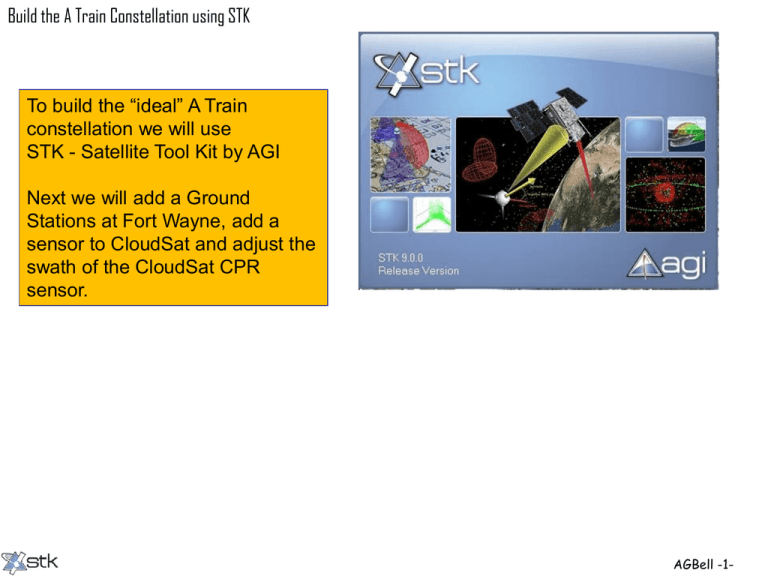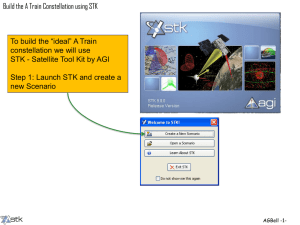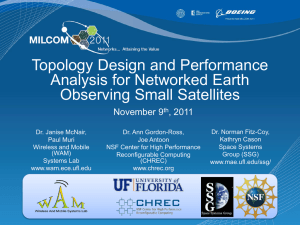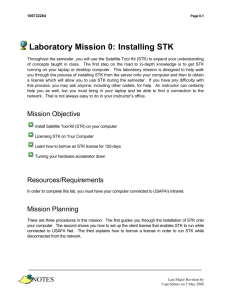Part 3 - Robust Design Concepts
advertisement

Build the A Train Constellation using STK To build the “ideal” A Train constellation we will use STK - Satellite Tool Kit by AGI Next we will add a Ground Stations at Fort Wayne, add a sensor to CloudSat and adjust the swath of the CloudSat CPR sensor. AGBell -1- Build the A Train Constellation using STK Lets add Fort Wayne to our A Train scenario. Select Insert>Facility From City Database. AGBell -2- Build the A Train Constellation using STK Type in and search for Fort Wayne and then select insert. AGBell -3- Build the A Train Constellation using STK Fort Wayne now shows up on the globe. AGBell -4- Build the A Train Constellation using STK How about if we wanted to determine when the satellites can communicate with the Fort Wayne ground station? Select Access AGBell -5- Build the A Train Constellation using STK Select all the satellites and then hit the “Compute” button. AGBell -6- Build the A Train Constellation using STK When the satellite can communicate to the Fort Wayne ground station a line appears between the satellite and Fort Wayne AGBell -7- Build the A Train Constellation using STK Let remove all the reference grids and vectors and add the CPR instrument to CloudSat AGBell -8- Build the A Train Constellation using STK To add an instrument select Insert>Object Catalog The Object Catalog form will pop-up and select “Sensor” AGBell -9- Build the A Train Constellation using STK The new sensor “footprint” or swath defaults to a Simple Conic, 45 degrees. AGBell -10- Build the A Train Constellation using STK CloudSat’s CPR actually has a rectangular swath. CloudSat swath 1. 4 km by 2.5 km AGBell -11- Build the A Train Constellation using STK The swath dimensions must be translated into angles. sin( ) RE sin( ) (eq 2) 90 (eq 3) (eq 1) cos( ) RE H sin( ) RE = C= H= = = = = Swath width = = = = Swath width = 6378 40,075 705 64.2 89.89 0.101528 0.011222 2.5 km km km degrees degrees degrees degrees km radius of the Earth Earth's circumfrence altitude angular radius of the Earth elevation angle nadir angle Earth central angle given given input determine input determine determine given Use equation 1 to determine Based on how big you want your “swath” to be Use equation 2 to determine Use equation 3 to determine 89.94 0.056855 0.006285 1.4 degrees elevation angle degrees nadir angle degrees Earth central angle km input determine determine given Two “nadir angles” entered into STK for Vertical and Horizontal Half Angles embedded spreadsheet http://www.smad.com/store/bookstore/stl/smad3err.pdf AGBell -12- Build the A Train Constellation using STK STK has some additional information of creating a rectangular sensor pattern in the STK help area. AGBell -13- Build the A Train Constellation using STK Entered the full angles not the half angles. It should get a swath that is twice as wide and twice as long? AGBell -14- Build the A Train Constellation using STK Width is 1.4 km? Using this tool measure the width and length of the swath. AGBell -15- Build the A Train Constellation using STK Length is 2.5 km? Swath size is 1.4 by 2.5 for the angles entered. Conclusion, if you use the spreadsheet “nadir angles” you do not need to divide by two. AGBell -16- Build the A Train Constellation using STK 6 ft 1/8 inch 0.5 miles By comparison using the calculated swath size (1.4 km) divided by the CloudSat altitude (705 km), a six foot man looks like 1/8 inch tall from a half a mile away and would be hard to see. Therefore, we will scale the size of the swath. We will scale the swath width and length by 50 times so we can see it better. We will make the swath 2.84° by 5.07° AGBell -17- Build the A Train Constellation using STK First we will change the Sensor Type to “Rectangular” AGBell -18- Build the A Train Constellation using STK With the Vertical Half Angle to 2.84°and the Horizontal Half Angle to 5.07°. Actually, is will make our swath area 2500X larger than the actual swath size for CloudSat’s CPR. AGBell -19- Build the A Train Constellation using STK Swath area increased by 2500X times or 8,740 km2 Click on the picture to see the scenario. Click to see measurement of the swath size AGBell -20-






